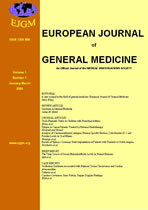
|
European Journal of General Medicine
Medical Investigations Society
ISSN: 1304-3897
Vol. 7, No. 2, 2010, pp. 155-160
|
 Bioline Code: gm10034
Bioline Code: gm10034
Full paper language: English
Document type: Research Article
Document available free of charge
|
|
|
European Journal of General Medicine, Vol. 7, No. 2, 2010, pp. 155-160
| tr |
Akciğer Kanserli Hastalarda Plazma D-dimer Düzeylerinin Prognostik Değeri
Ursavaş, Ahmet; Karadağ, Mehmet; Uzaslan, Esra; Yesilkaya, Selma; Coşkun, Funda & Eğe, Ercüment
Amaç: Malignitelerde koagülasyon ve fibrinolitik yolağın aktivasyonu sık görülür. Çalışmamızın amacı akciğer kanserli hastalarda D-dimer düzeylerini belirlemek ve kanser evresi, sürvi ve D-dimer düzeyleri arasındaki araştırmaktı.
Metod: Ocak 2005-Nisan 2007 tarihleri arasında merkezimizde tedavi edilen histolojik veya sitolojik olarak akciğer kanseri tanısı doğrulanmış 65 olgu çalışmaya alındı. Tüm olgular klinik değerlendirmelerine göre uygun yöntem ile tedavi edildi. Hastaların izlemi telefonla kendileri veya aile üyeleri ile görüşülerek yapıldı. Sürvi periyodu tanının konulduğu tarihten öldüğü veya çalışmanın tamamlandığı tarihe kadar geçen süre olarak tanımlandı.
Bulgular:Histolojik türler veya tümör evreleri arasında d-dimer düzeyleri açısından anlamlı farklılık saptanmadı. Plazma D-dimer düzeyleri yaşayan olgularda ölenlere göre anlamlı düzeyde düşük saptandı (p<0.05). Normal D-dimer düzeyi olanlar ortalama 426 gün (%95 GA 275-576 gün), yüksek D-dimer düzeyi olanlar ortalama 179 gün (%95 GA 68-289 gün) yaşadı ve plazma D-dimer düzeyi kötü prognozun güçlü bir belirteci olarak saptandı. Cox regresyon analizinde plazma D-dimer düzeyi yaş ve evreden bağımsız bulundu.
Sonuç: Akciğer kanserli hastalarda d-dimer düzeyi yaş ve evreden bağımsız prognostik faktördür.
Akciğer kanseri, D-dimer
|
| |
| en |
Prognostic Significance of Plasma D-Dimer Levels in Patients with Lung Cancer
Ursavaş, Ahmet; Karadağ, Mehmet; Uzaslan, Esra; Yesilkaya, Selma; Coşkun, Funda & Eğe, Ercüment
Abstract
Aim: Activation of coagulation and fibrinolysis pathways is frequently associated with malignancy. The objective of our study was to detect D-dimer levels in lung cancer patients and to determine whether there is any relationship between the stage of cancer and survival.
Method: From January 2005 to April 2007, sixty-five patients with histologically or cytologically confirmed lung cancer, treated at our institution were enrolled in the study. In each case, appropriate treatment modalities were recruited based on the clinical evaluation. Patients were followed up via phone calls to the patients themselves or their family members. Survival period was recorded as starting from the time of diagnosis to the date of death or termination of the study. Commercially available reagents were used to measure the levels of D-dimer.
Result: There was no significant difference between histological types and tumor stages in terms of D-dimer levels. The plasma D-dimer levels in the alive patients were significantly lower than patients that died (p <0.05). High plasma D-dimer concentrations turned out to be a strong predictor of poor outcome (median survival period in patients with normal D-dimer levels was 426 days [95% CI, 275-576 days] vs. 179 days [95% CI, 68-289 days] in patients with increased D-dimer levels; log rank statistics, 7.05; p <0.05). Cox regression analyses showed that D-dimer (p <0.05) was a prognostic factor, independent of age and stage.
Conclusion: We found that D-dimer was a prognostic factor, independent of age and disease stages
Keywords
Lung cancer, D-dimer
|
| |
© Copyright 2010 European Journal of General Medicine.
Alternative site location: http://www.ejgm.org
|
|
